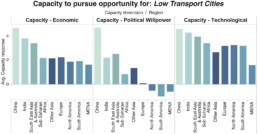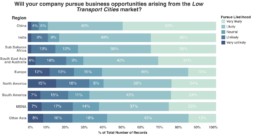Creating low transport cities mix the best parts of life in the small village and the big metropolis by placing everything within reach whether it is your home, your office, shops or recreational spaces. It can make cities car-free with fresh and clean air.
Imagine living in a city where all your activities are within reach on foot, by bike or by a well-connected transport system. Low transport cities are a new way of organizing life in urban areas, and together with technological trends, it can create cities with lower demands for transport of goods and people. Reducing the need for transport is the long-lasting approach to reducing emissions, but it is also a driver of productivity and quality of life in the city. Smarter zoning and planning can create great opportunities for cities to flourish – with clean air.

Cities With More Than One City Center
Many urban areas have been evolving rapidly without an overall plan for mobility – resulting in many cities having a mono-centric structure with one city centre. The city centre is, in many urban areas, where most of the central functions of the city are placed, including the services offered to residents as well as many workplaces. Urban residents often live in one area, work in another, and have other activities in a third. While this might have been practical at an age when workplaces were polluting a lot, the effect today is to spread out our activities geographically across much larger urban areas. This creates a high demand for transport due to most people having more than one activity per day.
New Technologies Reduce Transport Demand
Utilization of new technologies such as 3D printing to produce products close to the consumers instead of transporting prefabricated products around the world, and using video conferencing for meetings and consultations, can significantly reduce the need for transport.
An added benefit of shifting from personal cars to public transport, biking or even walking in cities is the enormous space that would be made available for purposes other than parking and roads. A car takes up approximately 180 square meters for roads and parking area, which is around 18 times more in comparison to busses or bikes.
All in all, planning for low transport cities with activities located closer to the users, providing non-motorized alternatives for transportation and utilizing already existing and emerging technologies to reduce the need for travel can lower transport emissions. Additional benefits to low-transport cities include greater productivity, less noise, better road safety, lower welfare costs (hospital etc.), reduced congestion, and more local jobs strengthening the local economy.
Survey Findings
Even though the opportunity also includes planning cities to be low transport cities from the start, retrofitting cities to minimize the demand for transportation of people and goods is also a way of reducing emissions. It can, however, be a costly endeavor that may go some way to explain the low scores this market opportunity attracted in our survey.

The market opportunity of low transport cities is the least favored market opportunity of the 15 markets surveyed in 2015. The market concerns the retrofitting of existing cities to discourage transport, which may seem as an overwhelming task. Hence, re-organizing cities is not seen as a worthwhile tool for addressing the risk of accelerating transport emissions. Of all sectors surveyed, the manufacturing sector is the most positive.
There is a slight variation in how this market opportunity is perceived between medium and high HDI countries. Medium HDI countries see greater potential in this market than higher HDI countries. It may be a signal that many of these countries are currently going through rapid urbanization processes with all the problems that go along with it in terms of congestion, insufficient capacity of the road network, and so forth. Respondents in Sub Saharan Africa see potential societal benefits in this market, but the region is perceived to lack the capacity to pursue it. This especially applies to the economic capacity which is seen to be limited.

The survey findings reveal that lack of political will power is the main factor holding back the capacity to pursue this market opportunity in South and North America and in the MENA region. China is the exception, as Chinese respondents perceive low transport cities to be a market well supported by civil society. The latter might reflect the challenges China is facing regarding air pollution throughout the country. Respondents in China have also rated this market opportunity in top five of all opportunities surveyed in 2015, also emphasizing the societal benefits of addressing air pollution in China.
This market was surveyed globally in 2015 by more than 5500 leaders from both the public and private sectors. The survey was conducted in collaboration with the research company YouGov. The survey results were originally published in the Global Opportunity Report 2016.

